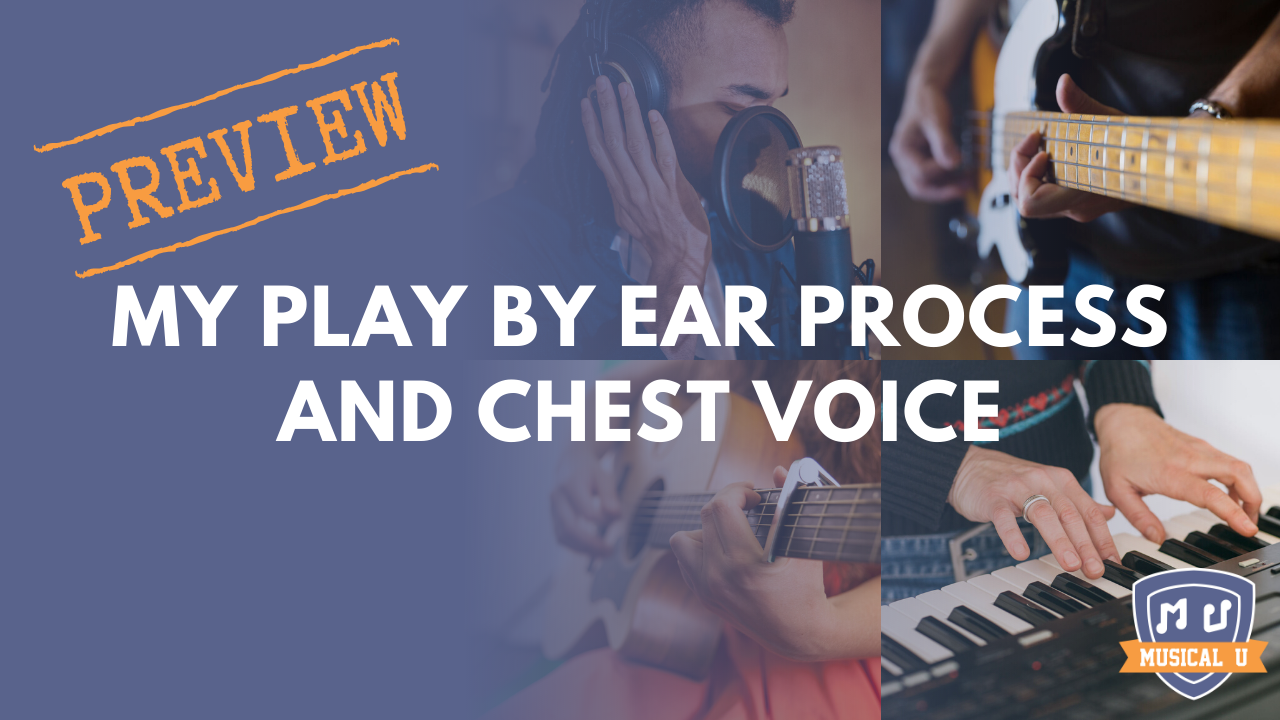Our Play By Ear series thus far has seen our Resident Pros exploring the different musical dimensions involved in this coveted skill: melody, basslines, chords, chord progressions, and rhythm.
For our final installment of the series, it’s time to bring the lessons of the past five Resource Packs together and show you just how you can learn a song by ear.
And what better way to do this than watch seasoned pros learn a song by ear in real time?!
For this pack, we asked each of our instrumental Resident Pros to compose and record a song, using whatever arrangement they liked. The Pros then swapped songs and recorded a video of themselves listening to the song and learning it, talking through their process and demonstrating the steps on their instrument. They then put together their own unique take on the original song, and uploaded it for your listening pleasure – and in the process, beautifully highlighting the best part of the play by ear process: putting your own spin on a tune.
Expect plenty of insights, tips, and tricks for streamlining the play-by-ear process – along with instrument-specific ideas on how you can, for example, effectively cover a strummed guitar tune on the piano!
Singers – this month, Resident Pro Clare Wheeler dives into the topic of how to use your chest voice, or how to explore those lower, thicker, and warmer tones of your range.
Singing
Have you always dreamed of singing in your lower register with more power and vocal intensity, à la Adele?
In this pack, Resident Pro Clare Wheeler explores the topic of singing in your chest voice, showing you how to best access those lower, thicker, and warmer tones when singing.
Including:
- A great warmup to get you ready before you practice singing
- Using an instrument to help find your chest voice range
- Exercises to get you started in using and controlling your chest voice
- Suggested parameters for safe vocal practice
Bass
For this Resource Pack’s learn-a-song switcheroo, Bass Pro Steve Lawson was given the task of learning an original composition by Piano Pro Ruth Power.
In his video demonstration, Steve translates Ruth’s piano-driven tune onto the bass guitar, walking you through his process and discussing what it means to cover a song in the process.
Including:
- Using reference songs to help you remember melodic motifs
- Using key characteristics of the music to hear section changes
- Putting together pieces of the song (harmony, rhythm, melody) to understand the whole
- MP3 tracks of both Ruth’s original and Steve’s cover
This Instrument Pack is the perfect demonstration of how a song can be re-interpreted for another instrument while keeping the essence of the original.
Guitar
An excellent trick for learning anything is breaking it down into smaller parts – smaller – smaller… perfect!
Dylan’s approach to learning Bass Pro Steve Lawson’s tune relies on breaking the song down into workable pieces – part-by-part, chord-by-chord, and in some places, note-by-note.
Including:
- Honing in on three key elements: melody, harmony, and structure
- Counting measures to determine the lengths of different parts of the song
- Extrapolating a chord progression from a bassline using solfa
- MP3 tracks of the original, plus various arrangements created by Dylan for you to practice playing along with
Dylan’s clear-cut, structural approach makes use of music theory and intuitive techniques to learn a song by ear without getting overwhelmed.
Piano
Translating a guitar song onto the piano comes with an added challenge – you have to translate rhythmic strumming patterns into a two-handed arrangement!
In her tutorial, Ruth demonstrates an excellent way to make Dylan’s original carry over to the piano, using her advanced ear training skills to find the notes, create harmonies, and effectively mimic a guitar rhythm.
Including:
- A simple trick for finding the first note
- Using ear training to easily elucidate melodies
- How to interpret a guitar strumming pattern on the piano
- What to do if you forget the exact melody of a song – a.k.a. how to make up what you don’t know with what you do know!
- MP3 tracks of Dylan’s original and Ruth’s Cover
Ruth is the first to admit that learning a song by ear is a challenging, sometimes-messy task, and that you’re likely to encounter at least a few bumps along the way. But as she notes, playing by ear isn’t about perfect replication – it’s about interpretation and creativity!
Coming up next month…
To follow up our multi-part play-by-ear saga, our instrumental Resident Pros tackle the fresh and jazzy ii-V-I chord progression, while Clare Wheeler provides more resources for your vocal development in a shiny new Singing Pack!







